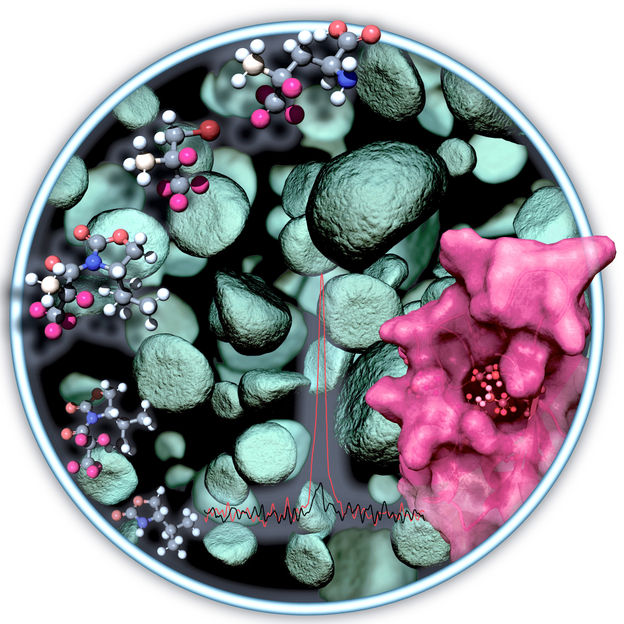Polymer Coatings Based on Molecular Structures
Researchers Developing a Novel Gel for Biological and Medical Applications
A novel method developed by researchers from Karlsruhe Institute of Technology (KIT) and Jacobs University Bremen enables manufacturing of polymer layers with tailor-made properties and multiple functions: A stable porous gel (SURGEL) for biological and medical applications is obtained from a metal-organic framework (SURMOF) grown up on a substrate. The method is presented in the Journal of the American Chemical Society.

Schematic diagram of a metal-organic framework (SURMOF, left), the framework after cross-linking (center), and after copper ions have dissolved out (right).
Dr. Manuel Tsotsalas/IFG
Coating of solids with polymers plays a central role in many areas of technological, natural and life sciences. For example, implants for the human body e.g., cardiac pacemakers, stents, or joint prostheses, need to be coated with suitable biomaterials and then impregnated with medical agents to accelerate healing-in and suppress inflammations. KIT researchers now have developed a completely novel method for producing a gel from cross-linked organic components. “Compared to conventional polymer coatings, this gel stands out by the fact that the pore size of the layers can be specifically adapted to the bioactive substances e.g., to pharmaceutical agents, to be embedded,” explains Professor Christof Wöll, Head of KIT’s Institute of Functional Interfaces (IFG).
The gel fabrication method developed by researchers from the KIT Institute of Functional Interfaces (IFG), Institute for Biological Interfaces (ITG), and Institute for Organic Chemistry (IOC) together with the Jacobs University Bremen consists of several steps: First, a layer of a so-called metal-organic framework (MOF) is grown up on a solid substrate. In the obtained SURMOF (SURface-mounted Metal Organic Framework) layer, the size, shape, and chemical functionality of the pores can be tailored, so to speak. The layer itself, however, is not suited for use in biological environments: Its pronounced sensitivity to water causes it to be degraded very rapidly and the copper ions contained in that special type of SURMOF are toxic to living beings.
In view of the above, the molecular components in the SURMOF are cross-linked with another molecule in a second step using the particularly efficient so-called click chemistry method which already at room temperature allows a complete reaction. In a third step, one dissolves out the copper ions from the framework until obtaining the remaining cross-linked organic components that form a porous polymer. This SURGEL provides a uniformly thick layer and combines the advantages of the SURMOF with a high stability under biological conditions.
The potential for biological and medical applications was demonstrated by the researchers by impregnating the SURGEL with a bioactive molecule and then populating it with microbes. The behavior of these simple cells showed that the released messenger molecules were incorporated extremely efficiently. “This new material class opens up entirely new possibilities of influencing cellular growth,” says Professor Martin Bastmeyer from KIT’s Zoological Institute who together with Professor Wöll heads the program “BioGrenzflächen” (biointerfaces) supported by the Helmholtz Association.
Both implementation of the novel polymer coating and its subsequent biological characterization have been demanding interdisciplinary cooperation of researchers in organic chemistry, biology, and physical chemistry from KIT and theorists from Jacobs University Bremen.























































